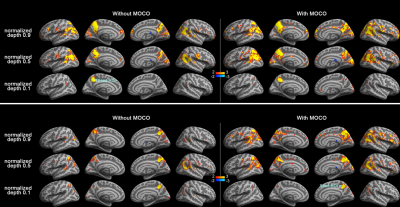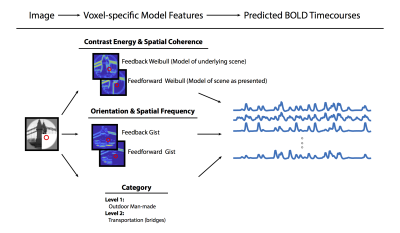Resolving Layers & Columnar Activity
Oral
fMRI
Tuesday, 19 June 2018
| N04 |
08:15 - 10:15 |
Moderators: David Norris, Rosa Sanchez Panchuelo |
08:15
 |
0388.
 |
 Functional Mapping of Body Part Representations across Layers and Columns in Humans Functional Mapping of Body Part Representations across Layers and Columns in Humans
Laurentius Huber, Jozien Goense, Pete Molfese, Daniel Glen, Dave Jangraw, Sriranga Kashyap, Benedikt Poser, Daniel Handwerker, Peter Bandettini
In this work, we seek to characterize the mesoscopic circuitry of the sensorimotor system across layers, columns and brain areas. We use a blood volume and BOLD signal sensitive fMRI methodology during task and rest with 0.78 mm resolution. We find ‘columnar’-dependent connectivity, representing the same body parts (e.g. digits) across different sensory and motor areas. In the hand knob, we find ‘columnar’ networks with a finer spatial scale than the regime of individual digit representations. Layer-dependent differences of task-induced and resting-state fMRI are indicative of different input-output-driven activity.
|
08:27
 |
0389.
 |
 Cortical depth dependent resting state fMRI with motion correction Cortical depth dependent resting state fMRI with motion correction
Ying-Hua Chu, Pu-Yeh Wu, Maxim Zaitsev, Yi-Cheng Hsu, Fa-Hsuan Lin
We used high resolution EPI (1 mm isotropic), cortical depth dependent analysis, and prospective motion correction (MOCO) to delineate the default mode network. Most sensitive within-subject characterization of the default-mode network was obtained from data at intermediate/superficial cortical depths with MOCO.
|
08:39
|
0390.
 |
 Improved spatial specificity of the early positive BOLD response observed with high-resolution fMRI at 3T Improved spatial specificity of the early positive BOLD response observed with high-resolution fMRI at 3T
Anna Blazejewska, Shahin Nasr, Jonathan Polimeni
Previous studies have demonstrated improved spatial specificity of conventional BOLD fMRI when restricting the analysis to the initial dip, however recent evidence suggests that it may be possible to achieve high specificity by restricting the analysis to the early phase of the response. Here we tested this concept by employing a spatial resolution test pattern in the visual cortex and observed the evolution of this pattern over time in signal subjects. We find that the spatial pattern of the early stages of the BOLD response appear to exhibit improved spatial specificity.
|
08:51
|
0391.
 |
 Columnar processing of acoustic features in human auditory cortex Columnar processing of acoustic features in human auditory cortex
Michelle Moerel, Federico De Martino, Kamil Ugurbil, Elia Formisano, Essa Yacoub
Using ultra-high field fMRI, we explored the cortical depth dependent stability of acoustic feature preference in human auditory cortex. In accordance with results from invasive recordings in cat auditory cortex, we observed a relatively stable (i.e., columnar) tuning to frequency and temporal modulations, while spectral modulation tuning was less stable throughout the cortical depth. This could represent simpler spectral tuning in middle auditory cortical layers, compared to more complex spectral tuning superficially. Furthermore, results suggest a coding strategy in which tuning to some features is kept stable orthogonal to the cortex, while tuning to other features systematically varies.
|
09:03
|
0392.
 |
 Cortical feedback to superficial layers of V1 contains predictive scene information. Cortical feedback to superficial layers of V1 contains predictive scene information.
Andrew Morgan, Federico De Martino, Lucy Petro, Rainer Goebel, Lars Muckli
A central characteristic of brain function is the ability to merge sensory input with internal representations of the world, but relatively little is known about cortical feedback channels that facilitate internal representations. We blocked feedforward input to subsections of human primary visual cortex by occluding one quarter of the visual field while participants viewed 384 real-world scenes. Using high-resolution 7T fMRI, we show that superficial layers of V1 exhibit predictive response properties unique from those associated with V1 feedforward processing. Our findings suggest that feedback to superficial layers of V1 provides neurons with contextual information not available via feedforward input.
|
09:15
|
0393.
 |
 Depth-dependent functional mapping of mental prediction in human somatosensory cortex Depth-dependent functional mapping of mental prediction in human somatosensory cortex
Yinghua Yu, Laurentius Huber, David Jangraw, Peter Molfese, Andrew Hall, Daniel Handwerker, Jiajia Yang, Peter Bandettini
High-resolution, cortical depth-dependent fMRI allows researchers to address questions about the feed-forward and feed-back driven activity non-invasively. The processing of finger-touching in the sensory cortex is a complex interplay between feed-forward activity from the thalamus and feed-back input from higher-order brain areas representing touching anticipation/prediction. Here we use high-resolution (0.7mm) fMRI at 7T to investigate this interplay in the human brain with BOLD and blood-volume-sensitive fMRI as a function of cortical depth. We find that we can reveal that prediction input in S1 is dominated from superficial layers, while thalamo-cortical feed-forward input is dominant in middle cortical layers, as expected from previous work in animals.
|
09:27
 |
0394.
 |
 True laminar resolution fMRI of the human visual cortex at 7T True laminar resolution fMRI of the human visual cortex at 7T
Sriranga Kashyap, Dimo Ivanov, Shubharthi Sengupta, Benedikt Poser, Kāmil Uludag
Current laminar BOLD fMRI studies at ultra-high field are typically carried out at sub-millimetre spatial resolution (~0.7mm isotropic), which, however, results in each voxel covering more than one cortical layer. Thus, layer-resolved activation profile can only be obtained if such data is analysed with post-processing tools at super-resolution. In this study, we demonstrate a novel functional mapping approach by acquiring fMRI data at true laminar resolution (100µm) in humans at 7T, compare it to the conventional high-resolution GE-EPI and analyse the depth-dependent BOLD signal change to visual stimulation.
|
09:39
|
0395.
 |
 The EPI rs-fMRI signal shows an orientation effect with respect to B0 and phase-encode axis across cortical depth The EPI rs-fMRI signal shows an orientation effect with respect to B0 and phase-encode axis across cortical depth
Olivia Viessmann, Marta Bianciardi, Klaus Scheffler, Lawrence Wald, Jonathan Polimeni
The cortex exhibits a strict vascular architecture and vessel orientation to the B0 field should impact the local susceptibility and hence the local BOLD signal. Cortical folding could thus lead to local variations in the signal. Here, we used high-resolution 7T EPI rs-fMRI data and found substantial variations of the signal amplitdude's coefficient of variation (σ/μ) with the local cortical orientation to B0. This effect was measurable throughout cortical depths with a maximised effect of +70% at the surface. We compare this to orientation-dependent blurring effects along the phase-encode axis, which we found to be significant too.
|
09:51
|
0396.
 |
 Estimating the Spatial Precision of Multivoxel Pattern of BOLD Response at 7T Estimating the Spatial Precision of Multivoxel Pattern of BOLD Response at 7T
Luca Vizioli, Lars Muckli, Federico Di Martino, Essa Yacoub
fMRI has limited spatial accuracy due to the vascular nature of the signal source. At high fields, sub-millimeter functional images can be acquired with the hopes of investigating cortical columns and/or layers. The efforts to improve the spatial accuracy of the signals tends to be focused on the acquisition side, rather than the analysis side. Here, we explore the use of multi-voxel pattern analysis as a means to circumvent the apparent spatial specificity limits of ultra-high field fMRI.
|
10:03
|
0397.
 |
 Hypercapnic and hyperoxic laminar calibrated BOLD: are conventional models adequate? Hypercapnic and hyperoxic laminar calibrated BOLD: are conventional models adequate?
Alberto Merola, Maria Guidi, Nikolaus Weiskopf
Several sub-millimetre-resolution fMRI acquisitions have been developed in recent years, however none taken singularly directly reflects neural activity. We use a calibrated BOLD approach combining BOLD and VASO measurements with respiratory manipulations (CO2 and O2) and a motor task to estimate cortical profiles of changes in O2 metabolism, a parameter more tightly related to neuronal function. Calculated hypercapnic calibration parameters are consistent with previous findings, while physiologically implausible estimates of O2 metabolism changes are found with hyperoxic calibration. A possible reason for this is reported, which questions the validity of conventional models for hyperoxic calibration at this resolution.
|
|













